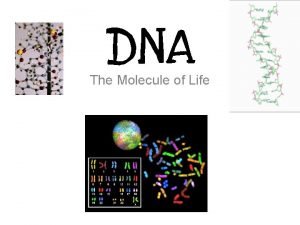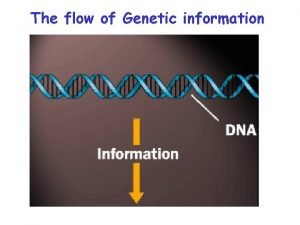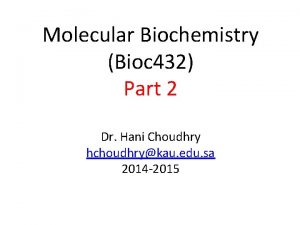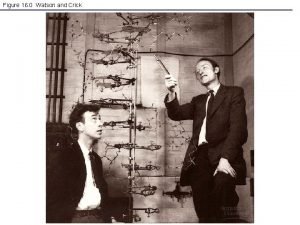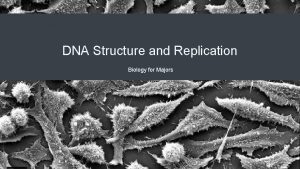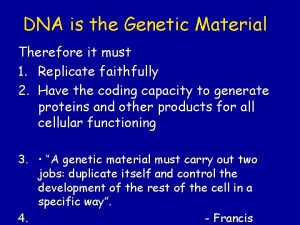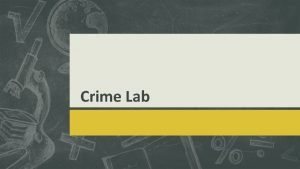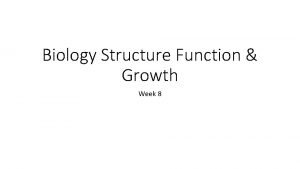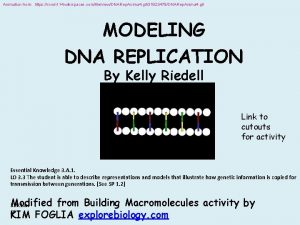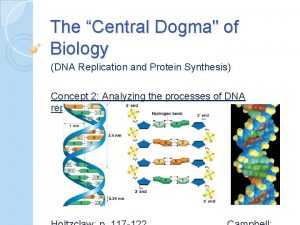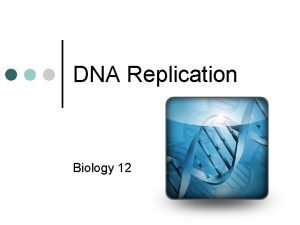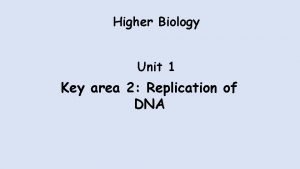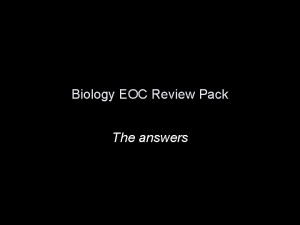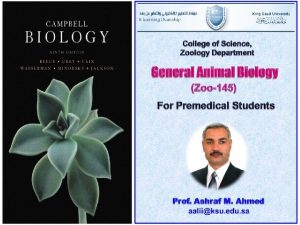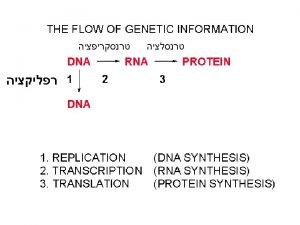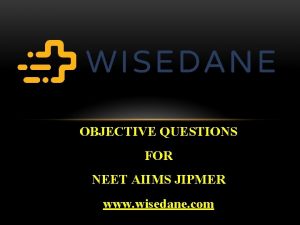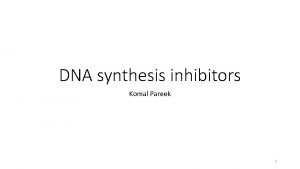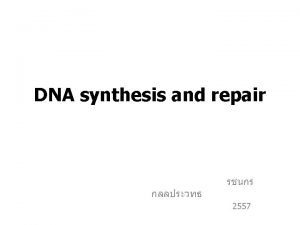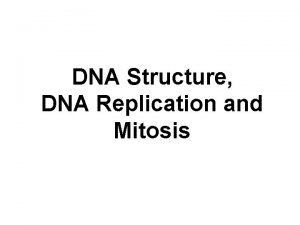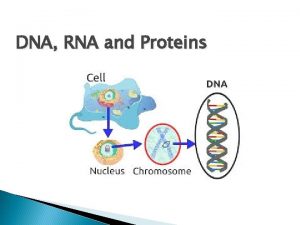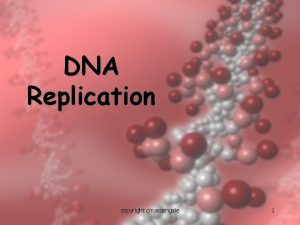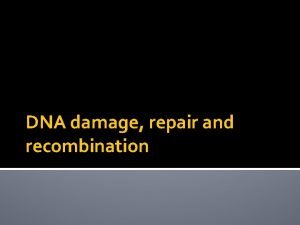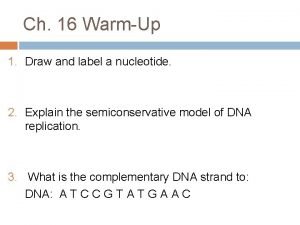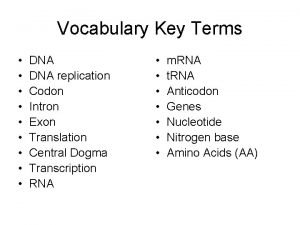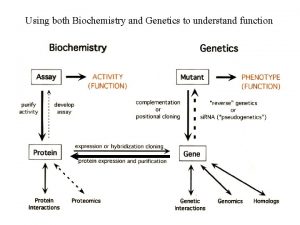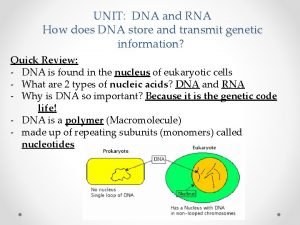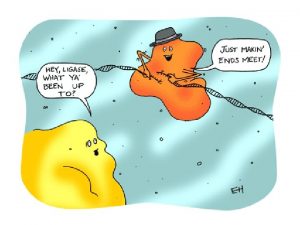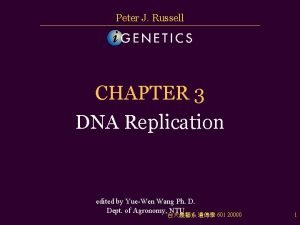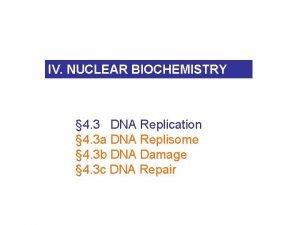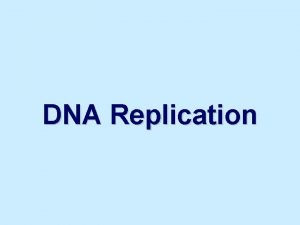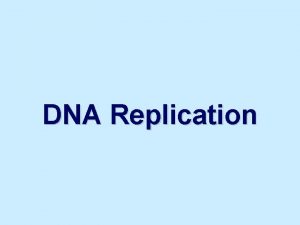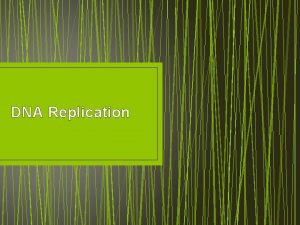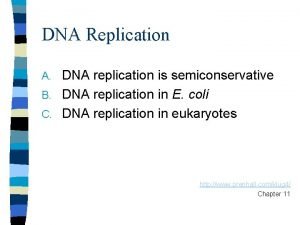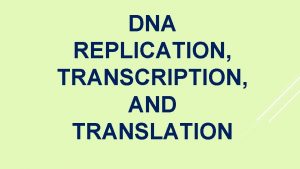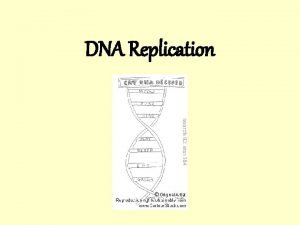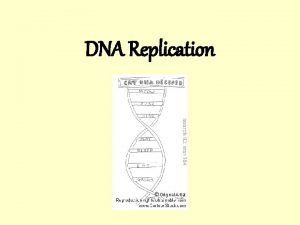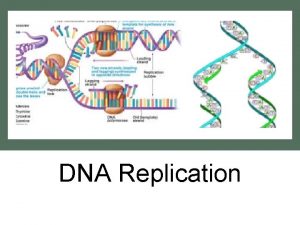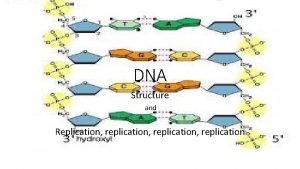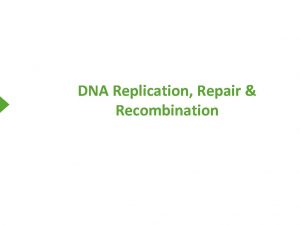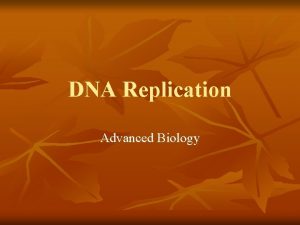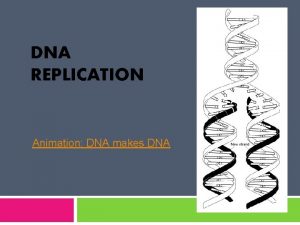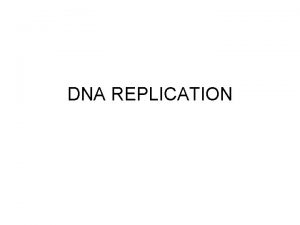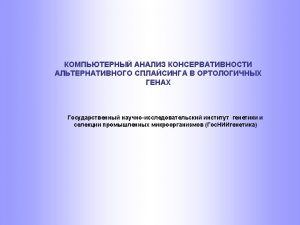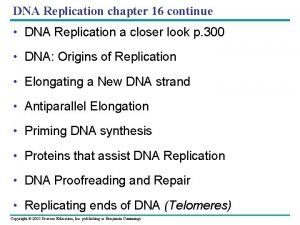DNA Replication When a cell or organism reproduces







































- Slides: 39

DNA Replication • When a cell or organism reproduces, a complete set of genetic instructions must pass from one generation to the next Copyright © 2004 Pearson Education, Inc. publishing as Benjamin Cummings

• Watson and Crick’s model for DNA suggested that DNA replicated by a template mechanism Parental (old) DNA molecule Daughter (new) strand Daughter DNA molecule (double helices) Figure 10. 6 Copyright © 2004 Pearson Education, Inc. publishing as Benjamin Cummings

THE FLOW OF GENETIC INFORMATION FROM DNA TO RNA TO PROTEIN • DNA functions as the inherited directions for a cell or organism – How are these directions carried out? Copyright © 2004 Pearson Education, Inc. publishing as Benjamin Cummings

How an Organism’s DNA Genotype Produces Its Phenotype • An organism’s genotype, its genetic makeup is the sequence of nucleotide bases in DNA – The phenotype is the organism’s specific traits Copyright © 2004 Pearson Education, Inc. publishing as Benjamin Cummings

• What is the language of nucleic acids? – In DNA, it is the linear sequence of nucleotide bases DNA molecule Gene 1 Gene 2 Gene 3 DNA strand Transcription RNA Translation Codon Polypeptide Amino acid Figure 10. 10 Copyright © 2004 Pearson Education, Inc. publishing as Benjamin Cummings

• DNA specifies the synthesis of proteins in two stages Nucleus DNA Transcription RNA – Transcription – Translation Protein Cytoplasm Figure 10. 9 Copyright © 2004 Pearson Education, Inc. publishing as Benjamin Cummings

• When DNA is transcribed, the result is an RNA molecule • RNA is then translated into a sequence of amino acids in a polypeptide Copyright © 2004 Pearson Education, Inc. publishing as Benjamin Cummings

Transcription: From DNA to RNA • In transcription – Genetic information is transferred from DNA to RNA – An RNA molecule is transcribed from a DNA template Copyright © 2004 Pearson Education, Inc. publishing as Benjamin Cummings

RNA nucleotides RNA polymerase Newly made RNA Direction of transcription Template strand of DNA (a) A close-up view of transcription Figure 10. 13 a Copyright © 2004 Pearson Education, Inc. publishing as Benjamin Cummings

• Transcription of an entire gene RNA polymerase DNA of gene Promoter DNA Initiation RNA Elongation Terminator DNA Area shown in part (a) Termination Growing RNA Completed RNA (b) Transcription of a gene Copyright © 2004 Pearson Education, Inc. publishing as Benjamin Cummings RNA polymerase Figure 10. 13 b

• RNA processing includes n Exo – Removing introns ron n Exo Intron Exon DNA Cap – Adding a cap and tail Int RNA transcript with cap and tail Transcription Addition of cap and tail Tail Introns removed Exons spliced together m. RNA – Splicing exons together Coding sequence Nucleus Cytoplasm Figure 10. 14 Copyright © 2004 Pearson Education, Inc. publishing as Benjamin Cummings

• Transcription and translation – Are the processes whereby genes control the structures and activities of cells Copyright © 2004 Pearson Education, Inc. publishing as Benjamin Cummings

• Triplets of bases – Specify all the amino acids – Are called codons Copyright © 2004 Pearson Education, Inc. publishing as Benjamin Cummings

The Genetic Code • The genetic code is the set of rules relating nucleotide sequence to amino acid sequence Figure 10. 11 Copyright © 2004 Pearson Education, Inc. publishing as Benjamin Cummings

• The genetic code is shared by all organisms Figure 10. 12 Copyright © 2004 Pearson Education, Inc. publishing as Benjamin Cummings

Translation: The Players • Translation – Is the conversion from the nucleic acid language to the protein language Copyright © 2004 Pearson Education, Inc. publishing as Benjamin Cummings

Messenger RNA (m. RNA) • m. RNA – Is the first ingredient for translation Copyright © 2004 Pearson Education, Inc. publishing as Benjamin Cummings

• An m. RNA molecule has a cap and tail that help it bind to the ribosome Start of genetic message Cap End Tail Figure 10. 17 Copyright © 2004 Pearson Education, Inc. publishing as Benjamin Cummings

Transfer RNA (t. RNA) • t. RNA – Acts as a molecular interpreter – Carries amino acids – Matches amino acids with codons in m. RNA using anticodons Amino acid attachment site Hydrogen bond RNA polynucleotide chain Anticodon Figure 10. 15 Copyright © 2004 Pearson Education, Inc. publishing as Benjamin Cummings

• A fully assembled ribosome holds t. RNA and m. RNA for use in translation Next amino acid to be added to polypeptide Growing polypeptide t. RNA m. RNA (b) Figure 10. 16 b Copyright © 2004 Pearson Education, Inc. publishing as Benjamin Cummings

• The process of elongation Amino acid Polypeptide P site Anticodon m. RNA A site Codons 1 Codon recognition Elongation 2 Peptide bond formation New peptide bond m. RNA movement 3 Translocation Copyright © 2004 Pearson Education, Inc. publishing as Benjamin Cummings Figure 10. 19

Mutations • A mutation – Is any change in the nucleotide sequence of DNA Normal hemoglobin DNA Mutant hemoglobin DNA m. RNA Normal hemoglobin Glu Sickle-cell hemoglobin Val Figure 10. 21 Copyright © 2004 Pearson Education, Inc. publishing as Benjamin Cummings

Mutagens • Mutations may result from – Errors in DNA replication – Physical or chemical agents called mutagens Copyright © 2004 Pearson Education, Inc. publishing as Benjamin Cummings

• DNA can be damaged by ultraviolet light – The enzymes and proteins involved in replication can repair the damage Figure 10. 7 Copyright © 2004 Pearson Education, Inc. publishing as Benjamin Cummings

• Although mutations are often harmful – They are the source of the rich diversity of genes in the living world – They contribute to the process of evolution by natural selection Figure 10. 23 Copyright © 2004 Pearson Education, Inc. publishing as Benjamin Cummings

VIRUSES: GENES IN PACKAGES • Viruses sit on the fence between life and nonlife – They exhibit some but not all characteristics of living organisms Figure 10. 24 Copyright © 2004 Pearson Education, Inc. publishing as Benjamin Cummings

Bacteriophages • Bacteriophages, or phages – Attack bacteria Head Tail fiber DNA of virus Bacterial cell Copyright © 2004 Pearson Education, Inc. publishing as Benjamin Cummings Figure 10. 25

Plant Viruses • Viruses that infect plants – Can stunt growth and diminish plant yields Protein RNA – Can spread throughout the entire plant Figure 10. 27 Copyright © 2004 Pearson Education, Inc. publishing as Benjamin Cummings

Protein spike VIRUS Protein coat Envelope Viral RNA (genome) Plasma membrane of host cell m. RNA 1 Entry 2 Uncoating 3 RNA synthesis by viral enzyme 4 Protein synthesis 5 RNA synthesis (other strand) 6 Assembly Template New viral genome New viral proteins Exit 7 Figure 10. 29 Copyright © 2004 Pearson Education, Inc. publishing as Benjamin Cummings

Copyright © 2004 Pearson Education, Inc. publishing as Benjamin Cummings

Copyright © 2004 Pearson Education, Inc. publishing as Benjamin Cummings

Copyright © 2004 Pearson Education, Inc. publishing as Benjamin Cummings

Copyright © 2004 Pearson Education, Inc. publishing as Benjamin Cummings

Copyright © 2004 Pearson Education, Inc. publishing as Benjamin Cummings

Copyright © 2004 Pearson Education, Inc. publishing as Benjamin Cummings

Copyright © 2004 Pearson Education, Inc. publishing as Benjamin Cummings

Copyright © 2004 Pearson Education, Inc. publishing as Benjamin Cummings

Signaling between biomolecules Copyright © 2004 Pearson Education, Inc. publishing as Benjamin Cummings

• Gene therapy Copyright © 2004 Pearson Education, Inc. publishing as Benjamin Cummings
 Bioflix activity dna replication dna replication diagram
Bioflix activity dna replication dna replication diagram Dna polymerase function in dna replication
Dna polymerase function in dna replication Dna and genes chapter 11
Dna and genes chapter 11 Food webs and energy pyramids answer key
Food webs and energy pyramids answer key Forms of dna
Forms of dna Dna meaning
Dna meaning 3-5 exonuclease vs 5-3 exonuclease
3-5 exonuclease vs 5-3 exonuclease 5 enzymes responsible for dna replication
5 enzymes responsible for dna replication 3 models of dna replication
3 models of dna replication Dna structure and replication packet answer key
Dna structure and replication packet answer key Major enzymes in dna replication
Major enzymes in dna replication Accgtat
Accgtat Dna jeopardy
Dna jeopardy Dna replication fork
Dna replication fork Dna replication vs pcr
Dna replication vs pcr What process
What process Kim foglia dna replication
Kim foglia dna replication Bioflix dna replication
Bioflix dna replication Protein synthesis restaurant analogy
Protein synthesis restaurant analogy Dna replication
Dna replication Dna replication transcription and translation
Dna replication transcription and translation Replication of dna higher biology
Replication of dna higher biology Why is dna replication considered semiconservative
Why is dna replication considered semiconservative Dna replication pearson
Dna replication pearson Dna replication direction 5' 3'
Dna replication direction 5' 3' Dna replication in bacteria occurs
Dna replication in bacteria occurs Dna replication
Dna replication Dna replication eukaryotes
Dna replication eukaryotes Dna replication
Dna replication Dna replication comic strip
Dna replication comic strip Dna replication facts
Dna replication facts Accuracy of dna replication
Accuracy of dna replication Bioflix dna replication
Bioflix dna replication Dna replication
Dna replication Dna synthesis at replication fork
Dna synthesis at replication fork Dna replication phschool
Dna replication phschool Primase
Primase Significance of replication
Significance of replication What role does dna polymerase play in copying dna?
What role does dna polymerase play in copying dna? Intercalating agents
Intercalating agents





